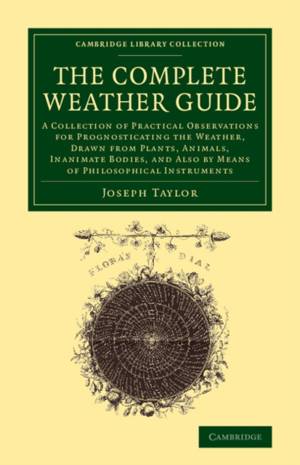
Je cadeautjes zeker op tijd in huis hebben voor de feestdagen? Kom langs in onze winkels en vind het perfecte geschenk!
- Afhalen na 1 uur in een winkel met voorraad
- Gratis thuislevering in België vanaf € 30
- Ruim aanbod met 7 miljoen producten
Je cadeautjes zeker op tijd in huis hebben voor de feestdagen? Kom langs in onze winkels en vind het perfecte geschenk!
- Afhalen na 1 uur in een winkel met voorraad
- Gratis thuislevering in België vanaf € 30
- Ruim aanbod met 7 miljoen producten
Zoeken
The Complete Weather Guide
A Collection of Practical Observations for Prognosticating the Weather, Drawn from Plants, Animals, Inanimate Bodies,
Joseph Taylor
€ 64,45
+ 128 punten
Omschrijving
Early nineteenth-century farmers often sowed their crops on an arbitrarily chosen day every year. Impatient with this practice, naturalist Joseph Taylor (c.1761-1844) presents an alternative method in this work, which first appeared in 1812. He argues that by studying the atmosphere, the behaviour of animals and the condition of local flora, a farmer can not only determine the optimal time for sowing, but also forecast the weather. Including the Shepherd of Banbury's famous rules for judging changes in the weather, alongside remarks on the quality of this wisdom, Taylor's book also draws on a wealth of wider countryside knowledge. He observes, for example, that the flowering of primroses and lettuce occurs at such precise times as to be useful for botanical clocks, while the proximity of bees to their hives and the agitation of dogs suggest oncoming weather conditions.
Specificaties
Betrokkenen
- Auteur(s):
- Uitgeverij:
Inhoud
- Aantal bladzijden:
- 174
- Taal:
- Engels
- Reeks:
Eigenschappen
- Productcode (EAN):
- 9781108065313
- Verschijningsdatum:
- 19/09/2013
- Uitvoering:
- Paperback
- Formaat:
- Trade paperback (VS)
- Afmetingen:
- 140 mm x 216 mm
- Gewicht:
- 226 g

Alleen bij Standaard Boekhandel
+ 128 punten op je klantenkaart van Standaard Boekhandel
Beoordelingen
We publiceren alleen reviews die voldoen aan de voorwaarden voor reviews. Bekijk onze voorwaarden voor reviews.









